Information Systems and IT Solutions Report for Big Data Analysis
VerifiedAdded on 2022/12/29
|13
|3179
|3
Report
AI Summary
This report provides a comprehensive overview of information systems and IT solutions, addressing their design, development, and application in business contexts. It begins by examining the theories, methods, and techniques related to the design and development of IT solutions, specifically focusing on Moodle and MS Office. The report then delves into various computer application programs, including Decision Support Systems (DSS), Executive Support Systems (ESS), Transaction Processing Systems (TPS), Management Information Systems (MIS), and Knowledge Management Systems (KSM), explaining their functions and providing relevant examples. Furthermore, it explores the effects of IT on globalization, highlighting the role of IT in facilitating international business operations and the increasing need for digital infrastructure. The report also defines digital infrastructure, outlining its advantages and disadvantages, and discusses the risks associated with information systems outsourcing, as well as the critical role of IT infrastructure in digital transformation. The report aims to provide insights into how information systems support management decisions at different levels within organizations, offering a detailed analysis of the methods and techniques used in the field of IT solutions and big data analysis.
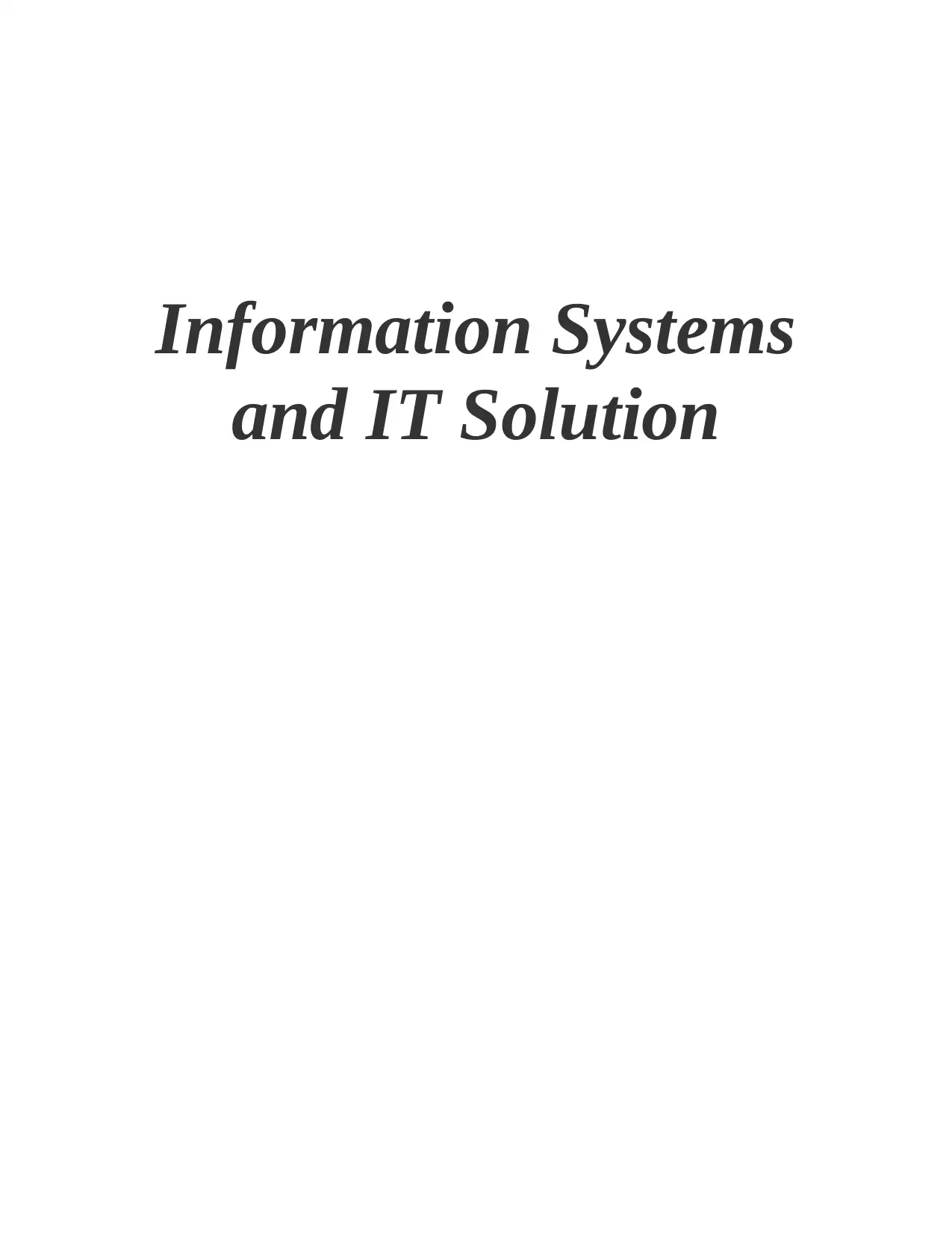
Information Systems
and IT Solution
and IT Solution
Paraphrase This Document
Need a fresh take? Get an instant paraphrase of this document with our AI Paraphraser
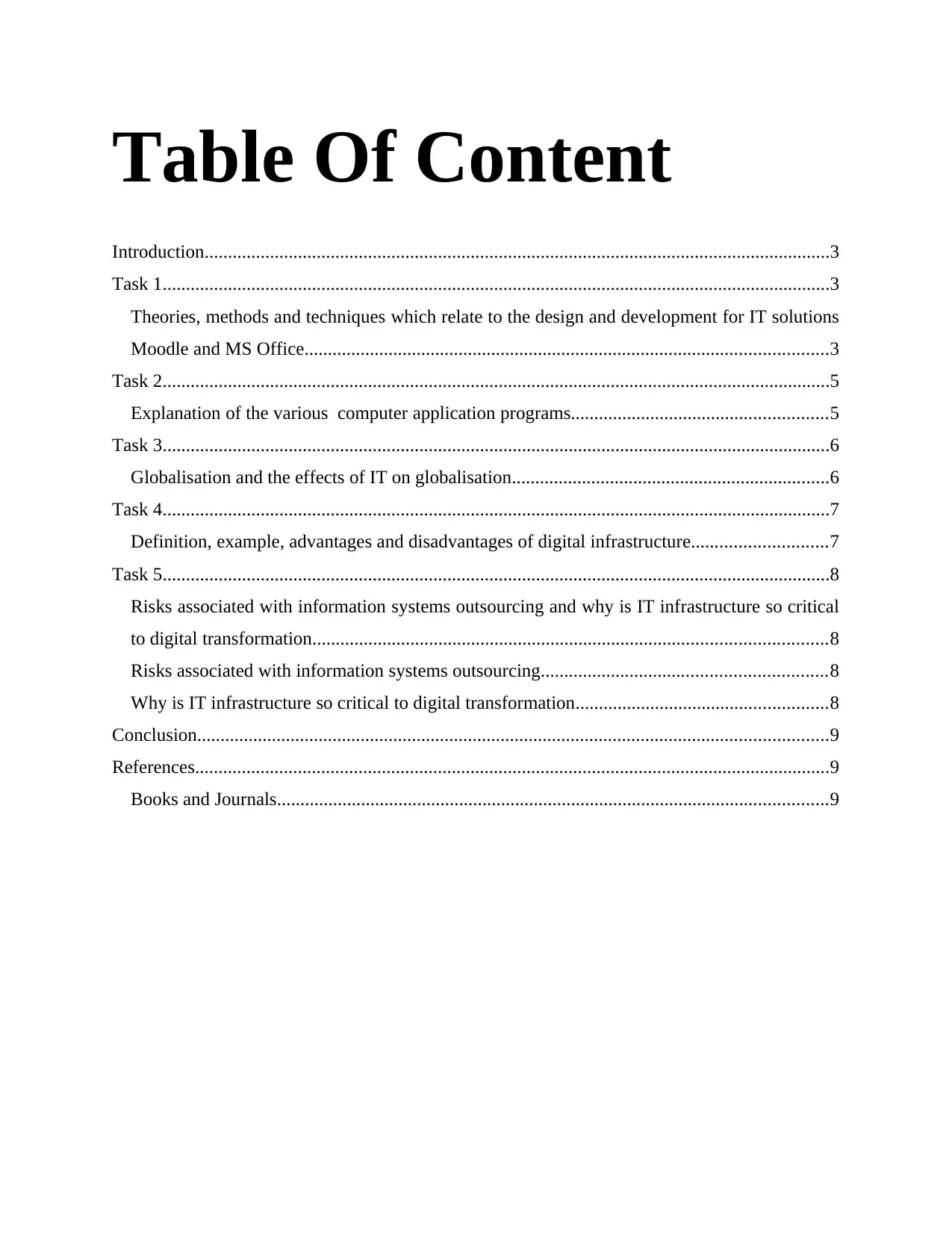
Table Of Content
Introduction......................................................................................................................................3
Task 1...............................................................................................................................................3
Theories, methods and techniques which relate to the design and development for IT solutions
Moodle and MS Office................................................................................................................3
Task 2...............................................................................................................................................5
Explanation of the various computer application programs.......................................................5
Task 3...............................................................................................................................................6
Globalisation and the effects of IT on globalisation....................................................................6
Task 4...............................................................................................................................................7
Definition, example, advantages and disadvantages of digital infrastructure.............................7
Task 5...............................................................................................................................................8
Risks associated with information systems outsourcing and why is IT infrastructure so critical
to digital transformation..............................................................................................................8
Risks associated with information systems outsourcing.............................................................8
Why is IT infrastructure so critical to digital transformation......................................................8
Conclusion.......................................................................................................................................9
References........................................................................................................................................9
Books and Journals......................................................................................................................9
Introduction......................................................................................................................................3
Task 1...............................................................................................................................................3
Theories, methods and techniques which relate to the design and development for IT solutions
Moodle and MS Office................................................................................................................3
Task 2...............................................................................................................................................5
Explanation of the various computer application programs.......................................................5
Task 3...............................................................................................................................................6
Globalisation and the effects of IT on globalisation....................................................................6
Task 4...............................................................................................................................................7
Definition, example, advantages and disadvantages of digital infrastructure.............................7
Task 5...............................................................................................................................................8
Risks associated with information systems outsourcing and why is IT infrastructure so critical
to digital transformation..............................................................................................................8
Risks associated with information systems outsourcing.............................................................8
Why is IT infrastructure so critical to digital transformation......................................................8
Conclusion.......................................................................................................................................9
References........................................................................................................................................9
Books and Journals......................................................................................................................9
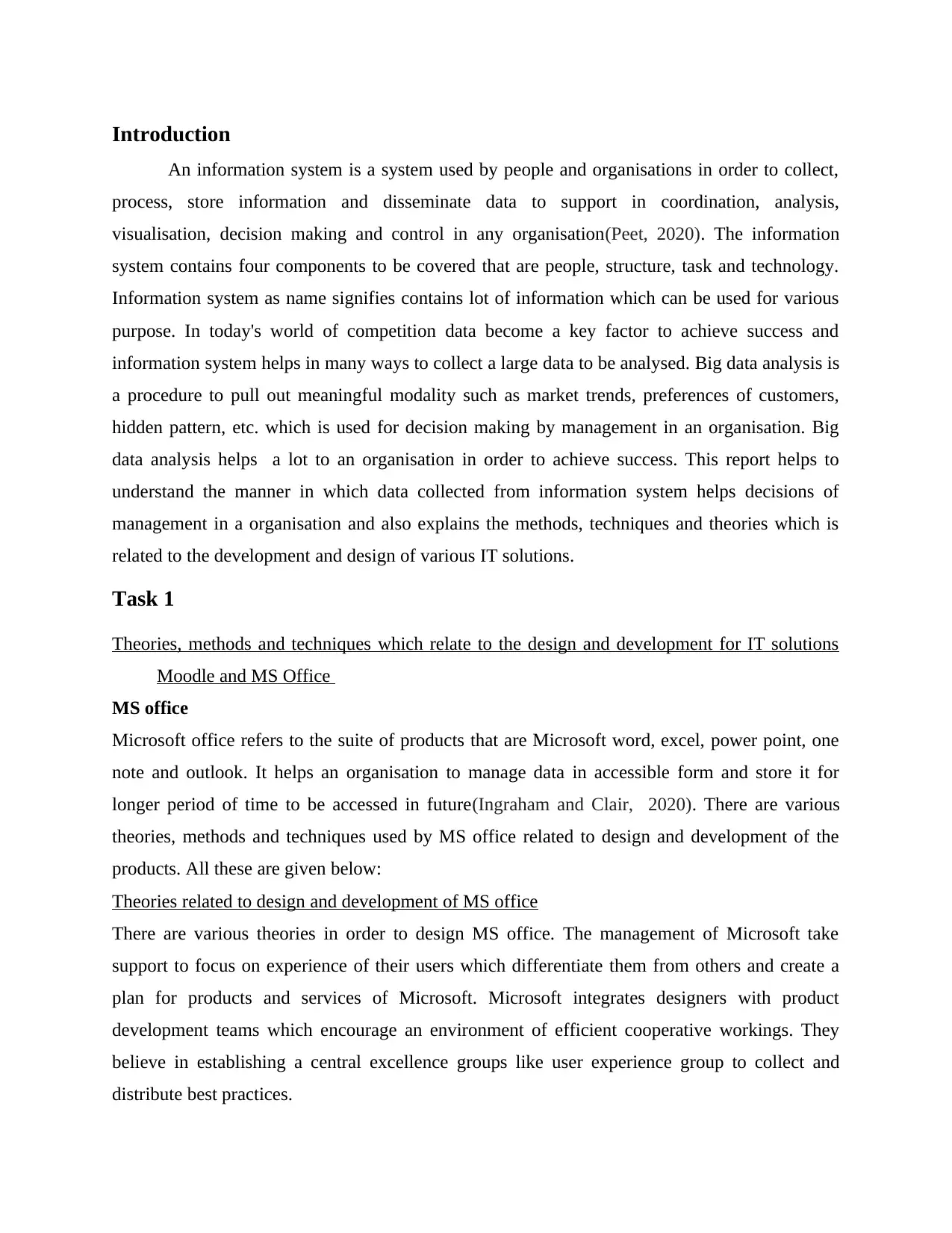
Introduction
An information system is a system used by people and organisations in order to collect,
process, store information and disseminate data to support in coordination, analysis,
visualisation, decision making and control in any organisation(Peet, 2020). The information
system contains four components to be covered that are people, structure, task and technology.
Information system as name signifies contains lot of information which can be used for various
purpose. In today's world of competition data become a key factor to achieve success and
information system helps in many ways to collect a large data to be analysed. Big data analysis is
a procedure to pull out meaningful modality such as market trends, preferences of customers,
hidden pattern, etc. which is used for decision making by management in an organisation. Big
data analysis helps a lot to an organisation in order to achieve success. This report helps to
understand the manner in which data collected from information system helps decisions of
management in a organisation and also explains the methods, techniques and theories which is
related to the development and design of various IT solutions.
Task 1
Theories, methods and techniques which relate to the design and development for IT solutions
Moodle and MS Office
MS office
Microsoft office refers to the suite of products that are Microsoft word, excel, power point, one
note and outlook. It helps an organisation to manage data in accessible form and store it for
longer period of time to be accessed in future(Ingraham and Clair, 2020). There are various
theories, methods and techniques used by MS office related to design and development of the
products. All these are given below:
Theories related to design and development of MS office
There are various theories in order to design MS office. The management of Microsoft take
support to focus on experience of their users which differentiate them from others and create a
plan for products and services of Microsoft. Microsoft integrates designers with product
development teams which encourage an environment of efficient cooperative workings. They
believe in establishing a central excellence groups like user experience group to collect and
distribute best practices.
An information system is a system used by people and organisations in order to collect,
process, store information and disseminate data to support in coordination, analysis,
visualisation, decision making and control in any organisation(Peet, 2020). The information
system contains four components to be covered that are people, structure, task and technology.
Information system as name signifies contains lot of information which can be used for various
purpose. In today's world of competition data become a key factor to achieve success and
information system helps in many ways to collect a large data to be analysed. Big data analysis is
a procedure to pull out meaningful modality such as market trends, preferences of customers,
hidden pattern, etc. which is used for decision making by management in an organisation. Big
data analysis helps a lot to an organisation in order to achieve success. This report helps to
understand the manner in which data collected from information system helps decisions of
management in a organisation and also explains the methods, techniques and theories which is
related to the development and design of various IT solutions.
Task 1
Theories, methods and techniques which relate to the design and development for IT solutions
Moodle and MS Office
MS office
Microsoft office refers to the suite of products that are Microsoft word, excel, power point, one
note and outlook. It helps an organisation to manage data in accessible form and store it for
longer period of time to be accessed in future(Ingraham and Clair, 2020). There are various
theories, methods and techniques used by MS office related to design and development of the
products. All these are given below:
Theories related to design and development of MS office
There are various theories in order to design MS office. The management of Microsoft take
support to focus on experience of their users which differentiate them from others and create a
plan for products and services of Microsoft. Microsoft integrates designers with product
development teams which encourage an environment of efficient cooperative workings. They
believe in establishing a central excellence groups like user experience group to collect and
distribute best practices.
⊘ This is a preview!⊘
Do you want full access?
Subscribe today to unlock all pages.

Trusted by 1+ million students worldwide
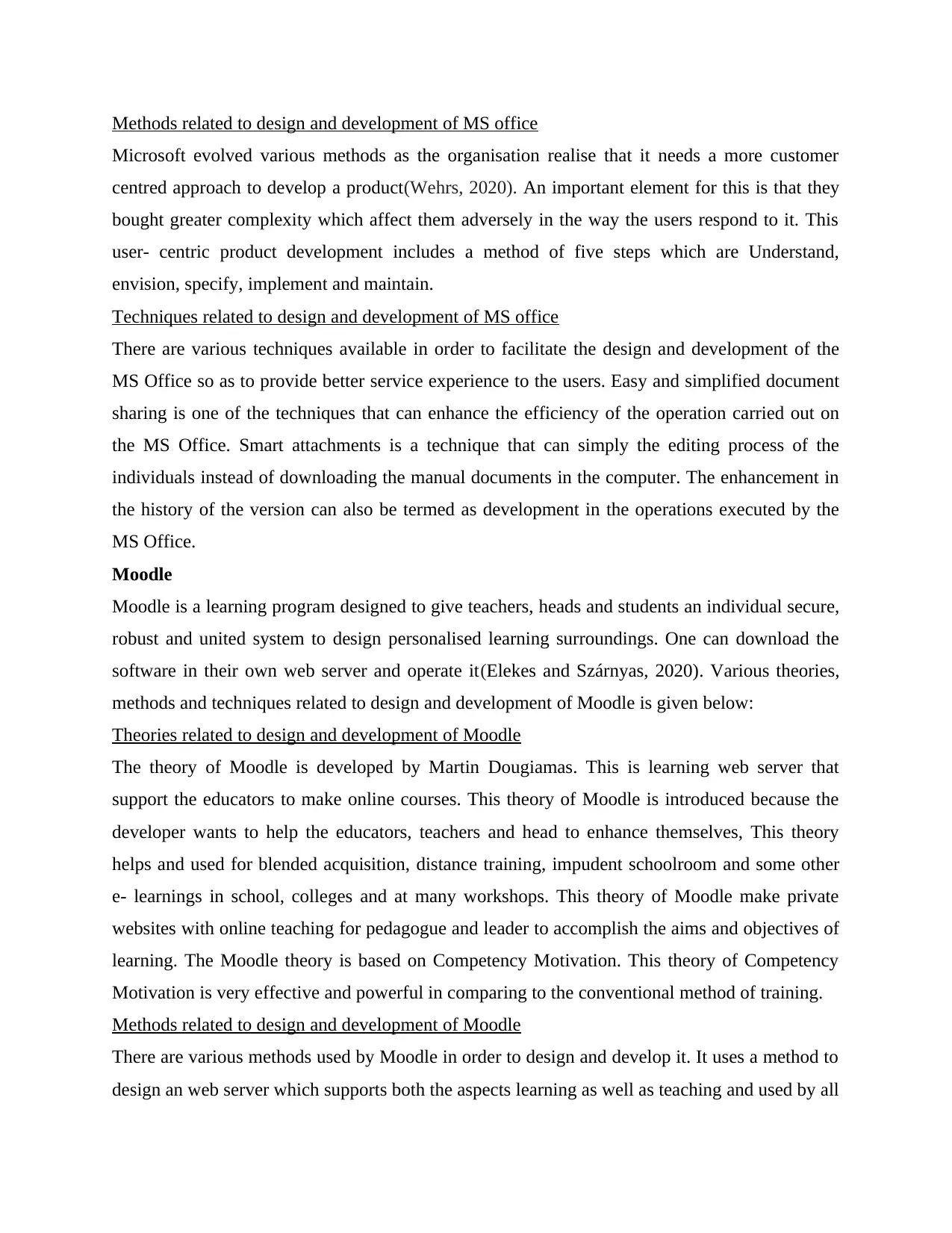
Methods related to design and development of MS office
Microsoft evolved various methods as the organisation realise that it needs a more customer
centred approach to develop a product(Wehrs, 2020). An important element for this is that they
bought greater complexity which affect them adversely in the way the users respond to it. This
user- centric product development includes a method of five steps which are Understand,
envision, specify, implement and maintain.
Techniques related to design and development of MS office
There are various techniques available in order to facilitate the design and development of the
MS Office so as to provide better service experience to the users. Easy and simplified document
sharing is one of the techniques that can enhance the efficiency of the operation carried out on
the MS Office. Smart attachments is a technique that can simply the editing process of the
individuals instead of downloading the manual documents in the computer. The enhancement in
the history of the version can also be termed as development in the operations executed by the
MS Office.
Moodle
Moodle is a learning program designed to give teachers, heads and students an individual secure,
robust and united system to design personalised learning surroundings. One can download the
software in their own web server and operate it(Elekes and Szárnyas, 2020). Various theories,
methods and techniques related to design and development of Moodle is given below:
Theories related to design and development of Moodle
The theory of Moodle is developed by Martin Dougiamas. This is learning web server that
support the educators to make online courses. This theory of Moodle is introduced because the
developer wants to help the educators, teachers and head to enhance themselves, This theory
helps and used for blended acquisition, distance training, impudent schoolroom and some other
e- learnings in school, colleges and at many workshops. This theory of Moodle make private
websites with online teaching for pedagogue and leader to accomplish the aims and objectives of
learning. The Moodle theory is based on Competency Motivation. This theory of Competency
Motivation is very effective and powerful in comparing to the conventional method of training.
Methods related to design and development of Moodle
There are various methods used by Moodle in order to design and develop it. It uses a method to
design an web server which supports both the aspects learning as well as teaching and used by all
Microsoft evolved various methods as the organisation realise that it needs a more customer
centred approach to develop a product(Wehrs, 2020). An important element for this is that they
bought greater complexity which affect them adversely in the way the users respond to it. This
user- centric product development includes a method of five steps which are Understand,
envision, specify, implement and maintain.
Techniques related to design and development of MS office
There are various techniques available in order to facilitate the design and development of the
MS Office so as to provide better service experience to the users. Easy and simplified document
sharing is one of the techniques that can enhance the efficiency of the operation carried out on
the MS Office. Smart attachments is a technique that can simply the editing process of the
individuals instead of downloading the manual documents in the computer. The enhancement in
the history of the version can also be termed as development in the operations executed by the
MS Office.
Moodle
Moodle is a learning program designed to give teachers, heads and students an individual secure,
robust and united system to design personalised learning surroundings. One can download the
software in their own web server and operate it(Elekes and Szárnyas, 2020). Various theories,
methods and techniques related to design and development of Moodle is given below:
Theories related to design and development of Moodle
The theory of Moodle is developed by Martin Dougiamas. This is learning web server that
support the educators to make online courses. This theory of Moodle is introduced because the
developer wants to help the educators, teachers and head to enhance themselves, This theory
helps and used for blended acquisition, distance training, impudent schoolroom and some other
e- learnings in school, colleges and at many workshops. This theory of Moodle make private
websites with online teaching for pedagogue and leader to accomplish the aims and objectives of
learning. The Moodle theory is based on Competency Motivation. This theory of Competency
Motivation is very effective and powerful in comparing to the conventional method of training.
Methods related to design and development of Moodle
There are various methods used by Moodle in order to design and develop it. It uses a method to
design an web server which supports both the aspects learning as well as teaching and used by all
Paraphrase This Document
Need a fresh take? Get an instant paraphrase of this document with our AI Paraphraser
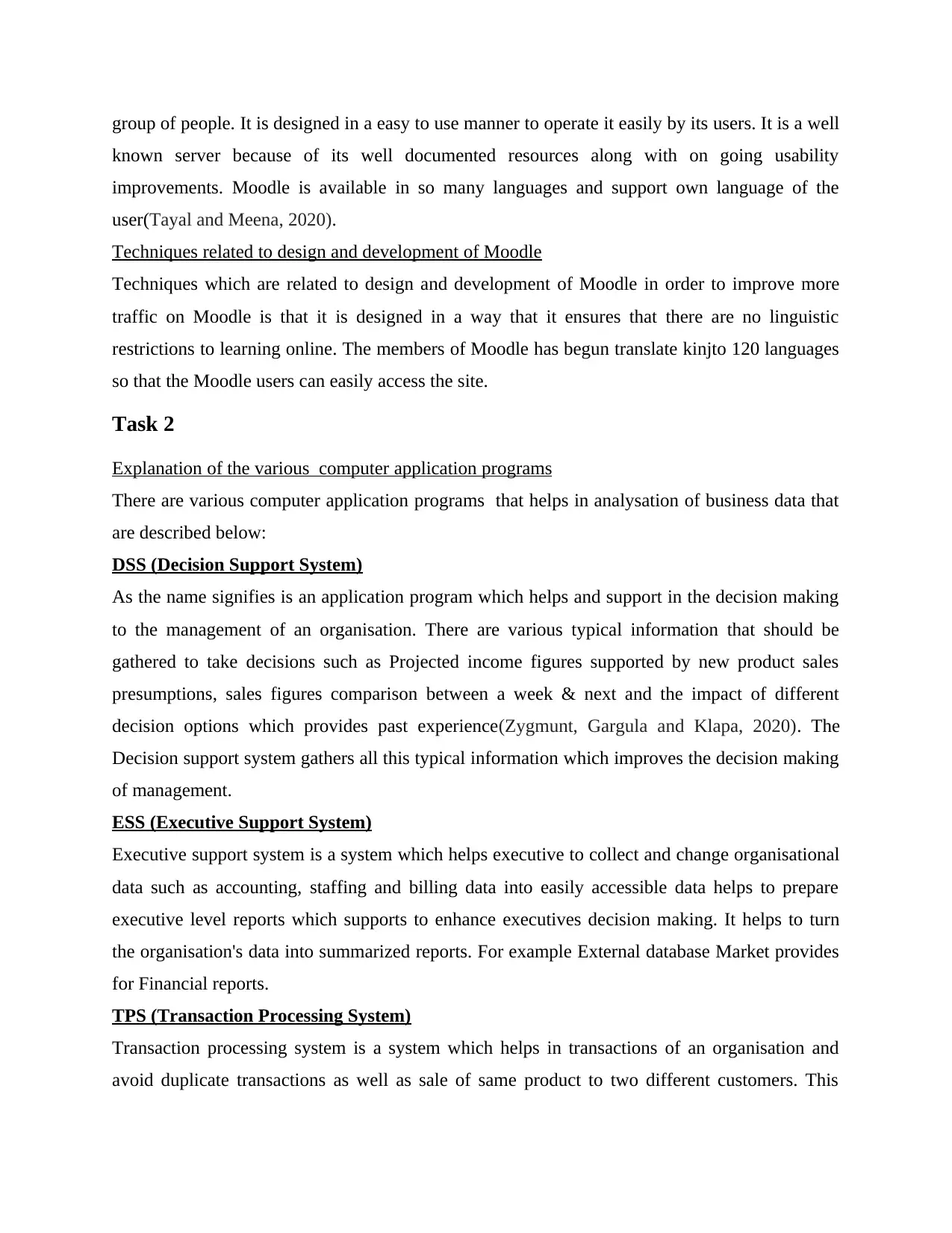
group of people. It is designed in a easy to use manner to operate it easily by its users. It is a well
known server because of its well documented resources along with on going usability
improvements. Moodle is available in so many languages and support own language of the
user(Tayal and Meena, 2020).
Techniques related to design and development of Moodle
Techniques which are related to design and development of Moodle in order to improve more
traffic on Moodle is that it is designed in a way that it ensures that there are no linguistic
restrictions to learning online. The members of Moodle has begun translate kinjto 120 languages
so that the Moodle users can easily access the site.
Task 2
Explanation of the various computer application programs
There are various computer application programs that helps in analysation of business data that
are described below:
DSS (Decision Support System)
As the name signifies is an application program which helps and support in the decision making
to the management of an organisation. There are various typical information that should be
gathered to take decisions such as Projected income figures supported by new product sales
presumptions, sales figures comparison between a week & next and the impact of different
decision options which provides past experience(Zygmunt, Gargula and Klapa, 2020). The
Decision support system gathers all this typical information which improves the decision making
of management.
ESS (Executive Support System)
Executive support system is a system which helps executive to collect and change organisational
data such as accounting, staffing and billing data into easily accessible data helps to prepare
executive level reports which supports to enhance executives decision making. It helps to turn
the organisation's data into summarized reports. For example External database Market provides
for Financial reports.
TPS (Transaction Processing System)
Transaction processing system is a system which helps in transactions of an organisation and
avoid duplicate transactions as well as sale of same product to two different customers. This
known server because of its well documented resources along with on going usability
improvements. Moodle is available in so many languages and support own language of the
user(Tayal and Meena, 2020).
Techniques related to design and development of Moodle
Techniques which are related to design and development of Moodle in order to improve more
traffic on Moodle is that it is designed in a way that it ensures that there are no linguistic
restrictions to learning online. The members of Moodle has begun translate kinjto 120 languages
so that the Moodle users can easily access the site.
Task 2
Explanation of the various computer application programs
There are various computer application programs that helps in analysation of business data that
are described below:
DSS (Decision Support System)
As the name signifies is an application program which helps and support in the decision making
to the management of an organisation. There are various typical information that should be
gathered to take decisions such as Projected income figures supported by new product sales
presumptions, sales figures comparison between a week & next and the impact of different
decision options which provides past experience(Zygmunt, Gargula and Klapa, 2020). The
Decision support system gathers all this typical information which improves the decision making
of management.
ESS (Executive Support System)
Executive support system is a system which helps executive to collect and change organisational
data such as accounting, staffing and billing data into easily accessible data helps to prepare
executive level reports which supports to enhance executives decision making. It helps to turn
the organisation's data into summarized reports. For example External database Market provides
for Financial reports.
TPS (Transaction Processing System)
Transaction processing system is a system which helps in transactions of an organisation and
avoid duplicate transactions as well as sale of same product to two different customers. This
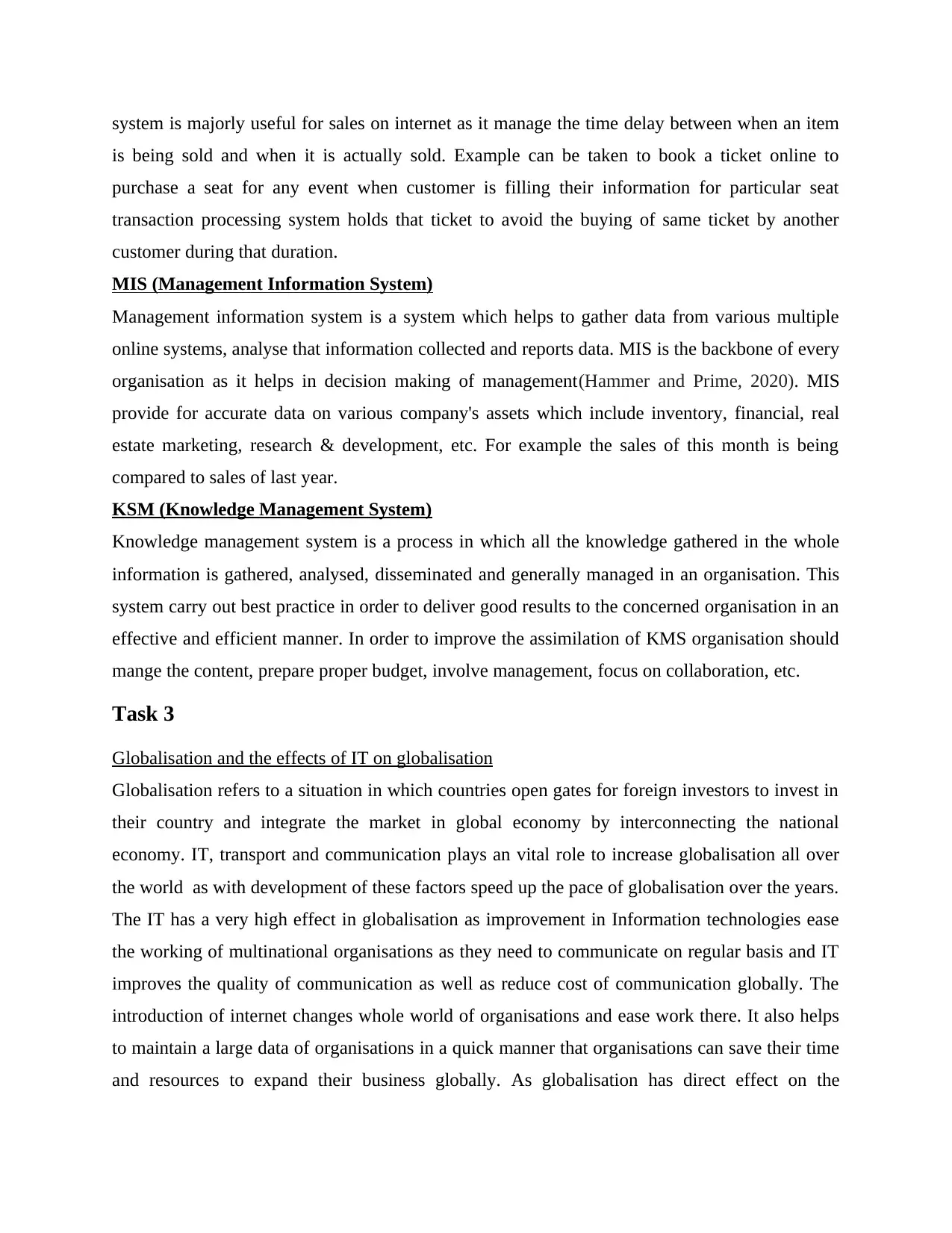
system is majorly useful for sales on internet as it manage the time delay between when an item
is being sold and when it is actually sold. Example can be taken to book a ticket online to
purchase a seat for any event when customer is filling their information for particular seat
transaction processing system holds that ticket to avoid the buying of same ticket by another
customer during that duration.
MIS (Management Information System)
Management information system is a system which helps to gather data from various multiple
online systems, analyse that information collected and reports data. MIS is the backbone of every
organisation as it helps in decision making of management(Hammer and Prime, 2020). MIS
provide for accurate data on various company's assets which include inventory, financial, real
estate marketing, research & development, etc. For example the sales of this month is being
compared to sales of last year.
KSM (Knowledge Management System)
Knowledge management system is a process in which all the knowledge gathered in the whole
information is gathered, analysed, disseminated and generally managed in an organisation. This
system carry out best practice in order to deliver good results to the concerned organisation in an
effective and efficient manner. In order to improve the assimilation of KMS organisation should
mange the content, prepare proper budget, involve management, focus on collaboration, etc.
Task 3
Globalisation and the effects of IT on globalisation
Globalisation refers to a situation in which countries open gates for foreign investors to invest in
their country and integrate the market in global economy by interconnecting the national
economy. IT, transport and communication plays an vital role to increase globalisation all over
the world as with development of these factors speed up the pace of globalisation over the years.
The IT has a very high effect in globalisation as improvement in Information technologies ease
the working of multinational organisations as they need to communicate on regular basis and IT
improves the quality of communication as well as reduce cost of communication globally. The
introduction of internet changes whole world of organisations and ease work there. It also helps
to maintain a large data of organisations in a quick manner that organisations can save their time
and resources to expand their business globally. As globalisation has direct effect on the
is being sold and when it is actually sold. Example can be taken to book a ticket online to
purchase a seat for any event when customer is filling their information for particular seat
transaction processing system holds that ticket to avoid the buying of same ticket by another
customer during that duration.
MIS (Management Information System)
Management information system is a system which helps to gather data from various multiple
online systems, analyse that information collected and reports data. MIS is the backbone of every
organisation as it helps in decision making of management(Hammer and Prime, 2020). MIS
provide for accurate data on various company's assets which include inventory, financial, real
estate marketing, research & development, etc. For example the sales of this month is being
compared to sales of last year.
KSM (Knowledge Management System)
Knowledge management system is a process in which all the knowledge gathered in the whole
information is gathered, analysed, disseminated and generally managed in an organisation. This
system carry out best practice in order to deliver good results to the concerned organisation in an
effective and efficient manner. In order to improve the assimilation of KMS organisation should
mange the content, prepare proper budget, involve management, focus on collaboration, etc.
Task 3
Globalisation and the effects of IT on globalisation
Globalisation refers to a situation in which countries open gates for foreign investors to invest in
their country and integrate the market in global economy by interconnecting the national
economy. IT, transport and communication plays an vital role to increase globalisation all over
the world as with development of these factors speed up the pace of globalisation over the years.
The IT has a very high effect in globalisation as improvement in Information technologies ease
the working of multinational organisations as they need to communicate on regular basis and IT
improves the quality of communication as well as reduce cost of communication globally. The
introduction of internet changes whole world of organisations and ease work there. It also helps
to maintain a large data of organisations in a quick manner that organisations can save their time
and resources to expand their business globally. As globalisation has direct effect on the
⊘ This is a preview!⊘
Do you want full access?
Subscribe today to unlock all pages.

Trusted by 1+ million students worldwide
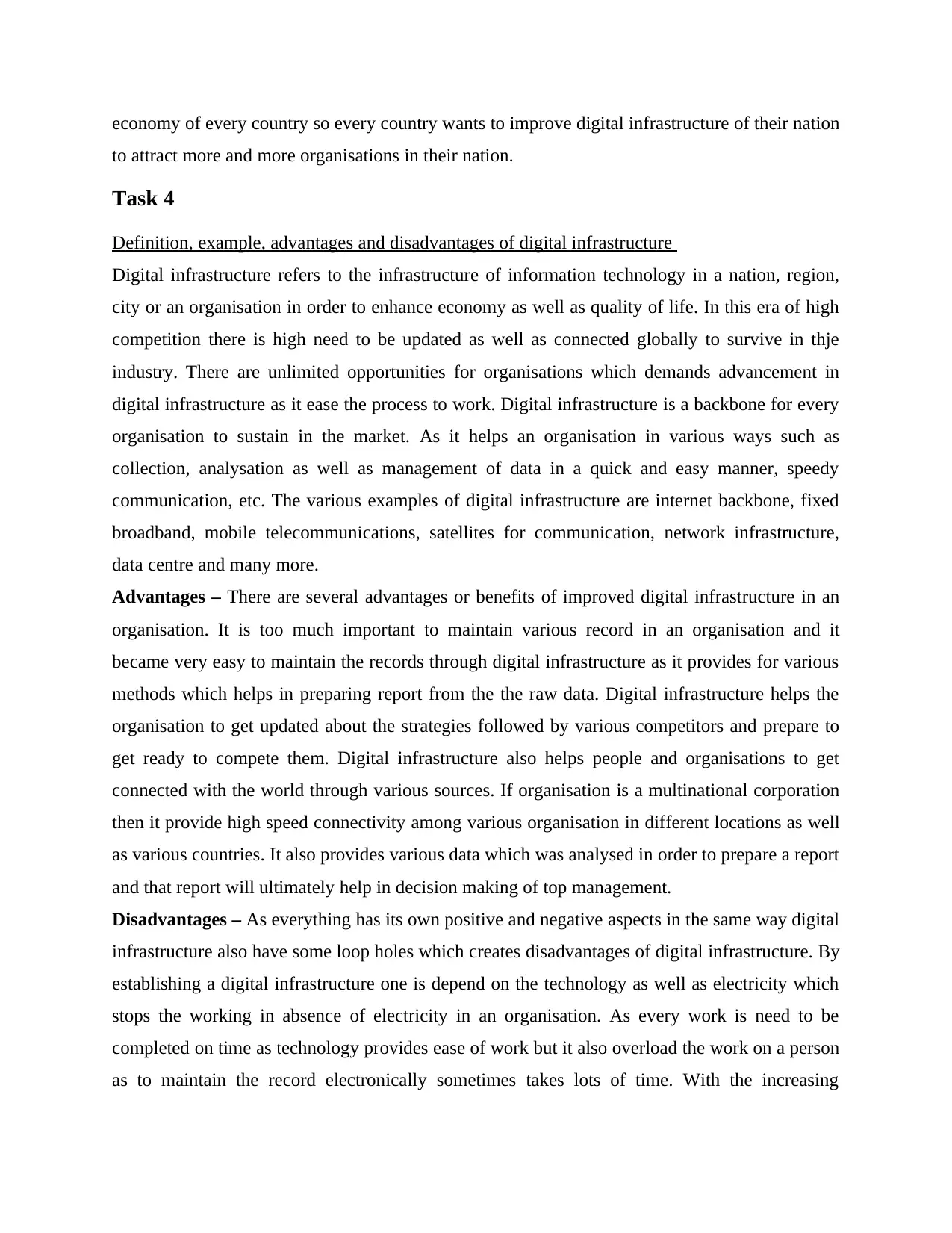
economy of every country so every country wants to improve digital infrastructure of their nation
to attract more and more organisations in their nation.
Task 4
Definition, example, advantages and disadvantages of digital infrastructure
Digital infrastructure refers to the infrastructure of information technology in a nation, region,
city or an organisation in order to enhance economy as well as quality of life. In this era of high
competition there is high need to be updated as well as connected globally to survive in thje
industry. There are unlimited opportunities for organisations which demands advancement in
digital infrastructure as it ease the process to work. Digital infrastructure is a backbone for every
organisation to sustain in the market. As it helps an organisation in various ways such as
collection, analysation as well as management of data in a quick and easy manner, speedy
communication, etc. The various examples of digital infrastructure are internet backbone, fixed
broadband, mobile telecommunications, satellites for communication, network infrastructure,
data centre and many more.
Advantages – There are several advantages or benefits of improved digital infrastructure in an
organisation. It is too much important to maintain various record in an organisation and it
became very easy to maintain the records through digital infrastructure as it provides for various
methods which helps in preparing report from the the raw data. Digital infrastructure helps the
organisation to get updated about the strategies followed by various competitors and prepare to
get ready to compete them. Digital infrastructure also helps people and organisations to get
connected with the world through various sources. If organisation is a multinational corporation
then it provide high speed connectivity among various organisation in different locations as well
as various countries. It also provides various data which was analysed in order to prepare a report
and that report will ultimately help in decision making of top management.
Disadvantages – As everything has its own positive and negative aspects in the same way digital
infrastructure also have some loop holes which creates disadvantages of digital infrastructure. By
establishing a digital infrastructure one is depend on the technology as well as electricity which
stops the working in absence of electricity in an organisation. As every work is need to be
completed on time as technology provides ease of work but it also overload the work on a person
as to maintain the record electronically sometimes takes lots of time. With the increasing
to attract more and more organisations in their nation.
Task 4
Definition, example, advantages and disadvantages of digital infrastructure
Digital infrastructure refers to the infrastructure of information technology in a nation, region,
city or an organisation in order to enhance economy as well as quality of life. In this era of high
competition there is high need to be updated as well as connected globally to survive in thje
industry. There are unlimited opportunities for organisations which demands advancement in
digital infrastructure as it ease the process to work. Digital infrastructure is a backbone for every
organisation to sustain in the market. As it helps an organisation in various ways such as
collection, analysation as well as management of data in a quick and easy manner, speedy
communication, etc. The various examples of digital infrastructure are internet backbone, fixed
broadband, mobile telecommunications, satellites for communication, network infrastructure,
data centre and many more.
Advantages – There are several advantages or benefits of improved digital infrastructure in an
organisation. It is too much important to maintain various record in an organisation and it
became very easy to maintain the records through digital infrastructure as it provides for various
methods which helps in preparing report from the the raw data. Digital infrastructure helps the
organisation to get updated about the strategies followed by various competitors and prepare to
get ready to compete them. Digital infrastructure also helps people and organisations to get
connected with the world through various sources. If organisation is a multinational corporation
then it provide high speed connectivity among various organisation in different locations as well
as various countries. It also provides various data which was analysed in order to prepare a report
and that report will ultimately help in decision making of top management.
Disadvantages – As everything has its own positive and negative aspects in the same way digital
infrastructure also have some loop holes which creates disadvantages of digital infrastructure. By
establishing a digital infrastructure one is depend on the technology as well as electricity which
stops the working in absence of electricity in an organisation. As every work is need to be
completed on time as technology provides ease of work but it also overload the work on a person
as to maintain the record electronically sometimes takes lots of time. With the increasing
Paraphrase This Document
Need a fresh take? Get an instant paraphrase of this document with our AI Paraphraser
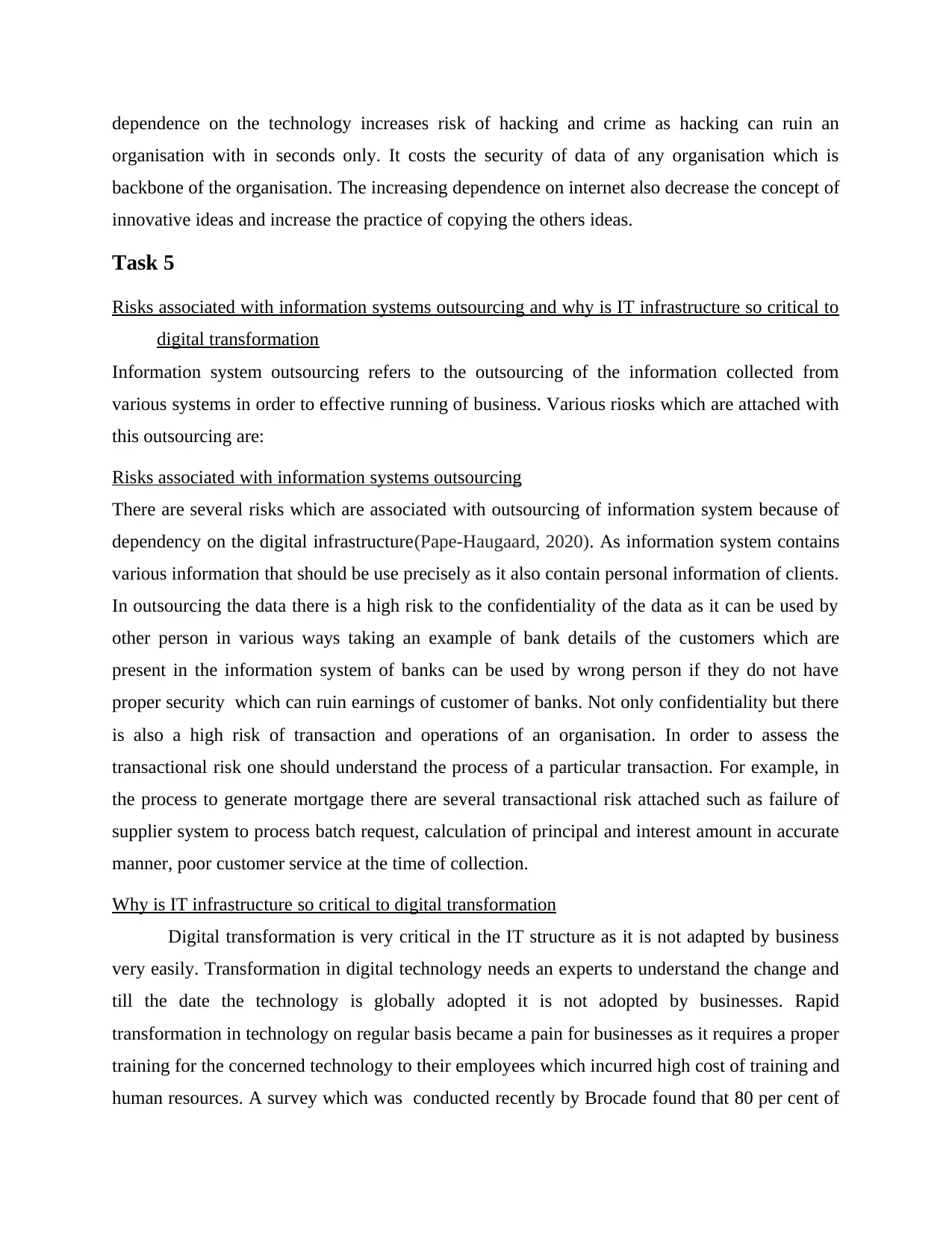
dependence on the technology increases risk of hacking and crime as hacking can ruin an
organisation with in seconds only. It costs the security of data of any organisation which is
backbone of the organisation. The increasing dependence on internet also decrease the concept of
innovative ideas and increase the practice of copying the others ideas.
Task 5
Risks associated with information systems outsourcing and why is IT infrastructure so critical to
digital transformation
Information system outsourcing refers to the outsourcing of the information collected from
various systems in order to effective running of business. Various riosks which are attached with
this outsourcing are:
Risks associated with information systems outsourcing
There are several risks which are associated with outsourcing of information system because of
dependency on the digital infrastructure(Pape-Haugaard, 2020). As information system contains
various information that should be use precisely as it also contain personal information of clients.
In outsourcing the data there is a high risk to the confidentiality of the data as it can be used by
other person in various ways taking an example of bank details of the customers which are
present in the information system of banks can be used by wrong person if they do not have
proper security which can ruin earnings of customer of banks. Not only confidentiality but there
is also a high risk of transaction and operations of an organisation. In order to assess the
transactional risk one should understand the process of a particular transaction. For example, in
the process to generate mortgage there are several transactional risk attached such as failure of
supplier system to process batch request, calculation of principal and interest amount in accurate
manner, poor customer service at the time of collection.
Why is IT infrastructure so critical to digital transformation
Digital transformation is very critical in the IT structure as it is not adapted by business
very easily. Transformation in digital technology needs an experts to understand the change and
till the date the technology is globally adopted it is not adopted by businesses. Rapid
transformation in technology on regular basis became a pain for businesses as it requires a proper
training for the concerned technology to their employees which incurred high cost of training and
human resources. A survey which was conducted recently by Brocade found that 80 per cent of
organisation with in seconds only. It costs the security of data of any organisation which is
backbone of the organisation. The increasing dependence on internet also decrease the concept of
innovative ideas and increase the practice of copying the others ideas.
Task 5
Risks associated with information systems outsourcing and why is IT infrastructure so critical to
digital transformation
Information system outsourcing refers to the outsourcing of the information collected from
various systems in order to effective running of business. Various riosks which are attached with
this outsourcing are:
Risks associated with information systems outsourcing
There are several risks which are associated with outsourcing of information system because of
dependency on the digital infrastructure(Pape-Haugaard, 2020). As information system contains
various information that should be use precisely as it also contain personal information of clients.
In outsourcing the data there is a high risk to the confidentiality of the data as it can be used by
other person in various ways taking an example of bank details of the customers which are
present in the information system of banks can be used by wrong person if they do not have
proper security which can ruin earnings of customer of banks. Not only confidentiality but there
is also a high risk of transaction and operations of an organisation. In order to assess the
transactional risk one should understand the process of a particular transaction. For example, in
the process to generate mortgage there are several transactional risk attached such as failure of
supplier system to process batch request, calculation of principal and interest amount in accurate
manner, poor customer service at the time of collection.
Why is IT infrastructure so critical to digital transformation
Digital transformation is very critical in the IT structure as it is not adapted by business
very easily. Transformation in digital technology needs an experts to understand the change and
till the date the technology is globally adopted it is not adopted by businesses. Rapid
transformation in technology on regular basis became a pain for businesses as it requires a proper
training for the concerned technology to their employees which incurred high cost of training and
human resources. A survey which was conducted recently by Brocade found that 80 per cent of
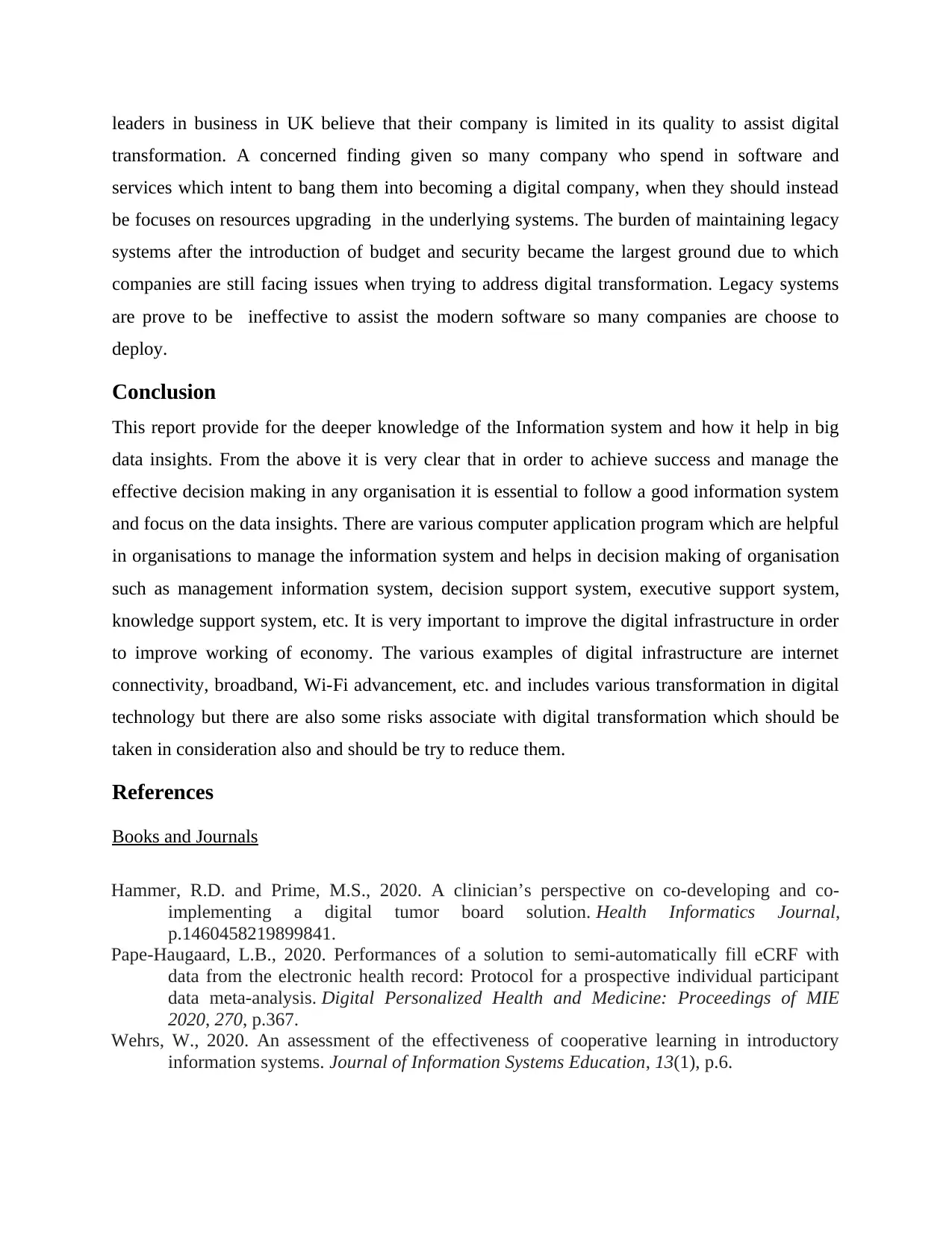
leaders in business in UK believe that their company is limited in its quality to assist digital
transformation. A concerned finding given so many company who spend in software and
services which intent to bang them into becoming a digital company, when they should instead
be focuses on resources upgrading in the underlying systems. The burden of maintaining legacy
systems after the introduction of budget and security became the largest ground due to which
companies are still facing issues when trying to address digital transformation. Legacy systems
are prove to be ineffective to assist the modern software so many companies are choose to
deploy.
Conclusion
This report provide for the deeper knowledge of the Information system and how it help in big
data insights. From the above it is very clear that in order to achieve success and manage the
effective decision making in any organisation it is essential to follow a good information system
and focus on the data insights. There are various computer application program which are helpful
in organisations to manage the information system and helps in decision making of organisation
such as management information system, decision support system, executive support system,
knowledge support system, etc. It is very important to improve the digital infrastructure in order
to improve working of economy. The various examples of digital infrastructure are internet
connectivity, broadband, Wi-Fi advancement, etc. and includes various transformation in digital
technology but there are also some risks associate with digital transformation which should be
taken in consideration also and should be try to reduce them.
References
Books and Journals
Hammer, R.D. and Prime, M.S., 2020. A clinician’s perspective on co-developing and co-
implementing a digital tumor board solution. Health Informatics Journal,
p.1460458219899841.
Pape-Haugaard, L.B., 2020. Performances of a solution to semi-automatically fill eCRF with
data from the electronic health record: Protocol for a prospective individual participant
data meta-analysis. Digital Personalized Health and Medicine: Proceedings of MIE
2020, 270, p.367.
Wehrs, W., 2020. An assessment of the effectiveness of cooperative learning in introductory
information systems. Journal of Information Systems Education, 13(1), p.6.
transformation. A concerned finding given so many company who spend in software and
services which intent to bang them into becoming a digital company, when they should instead
be focuses on resources upgrading in the underlying systems. The burden of maintaining legacy
systems after the introduction of budget and security became the largest ground due to which
companies are still facing issues when trying to address digital transformation. Legacy systems
are prove to be ineffective to assist the modern software so many companies are choose to
deploy.
Conclusion
This report provide for the deeper knowledge of the Information system and how it help in big
data insights. From the above it is very clear that in order to achieve success and manage the
effective decision making in any organisation it is essential to follow a good information system
and focus on the data insights. There are various computer application program which are helpful
in organisations to manage the information system and helps in decision making of organisation
such as management information system, decision support system, executive support system,
knowledge support system, etc. It is very important to improve the digital infrastructure in order
to improve working of economy. The various examples of digital infrastructure are internet
connectivity, broadband, Wi-Fi advancement, etc. and includes various transformation in digital
technology but there are also some risks associate with digital transformation which should be
taken in consideration also and should be try to reduce them.
References
Books and Journals
Hammer, R.D. and Prime, M.S., 2020. A clinician’s perspective on co-developing and co-
implementing a digital tumor board solution. Health Informatics Journal,
p.1460458219899841.
Pape-Haugaard, L.B., 2020. Performances of a solution to semi-automatically fill eCRF with
data from the electronic health record: Protocol for a prospective individual participant
data meta-analysis. Digital Personalized Health and Medicine: Proceedings of MIE
2020, 270, p.367.
Wehrs, W., 2020. An assessment of the effectiveness of cooperative learning in introductory
information systems. Journal of Information Systems Education, 13(1), p.6.
⊘ This is a preview!⊘
Do you want full access?
Subscribe today to unlock all pages.

Trusted by 1+ million students worldwide
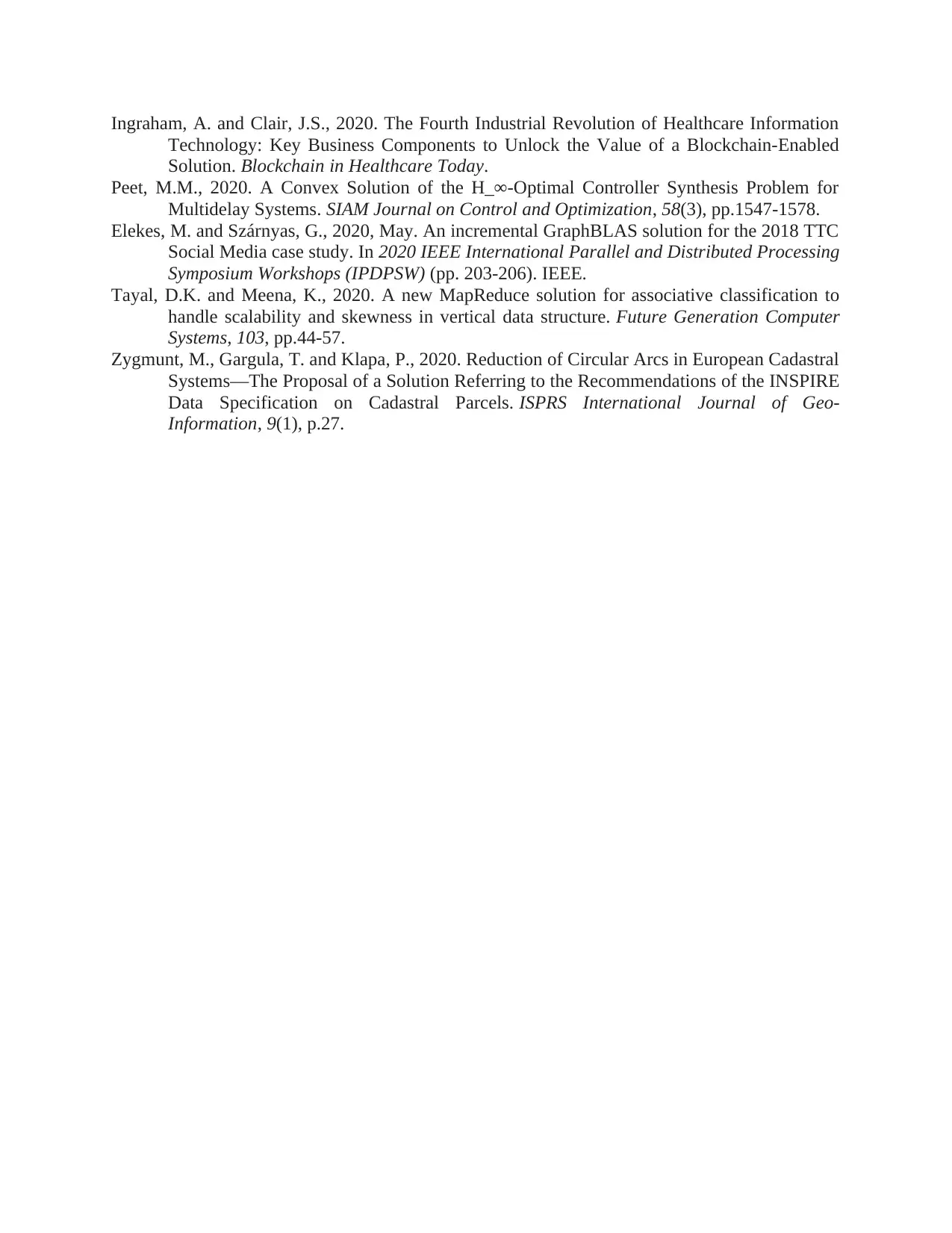
Ingraham, A. and Clair, J.S., 2020. The Fourth Industrial Revolution of Healthcare Information
Technology: Key Business Components to Unlock the Value of a Blockchain-Enabled
Solution. Blockchain in Healthcare Today.
Peet, M.M., 2020. A Convex Solution of the H_∞-Optimal Controller Synthesis Problem for
Multidelay Systems. SIAM Journal on Control and Optimization, 58(3), pp.1547-1578.
Elekes, M. and Szárnyas, G., 2020, May. An incremental GraphBLAS solution for the 2018 TTC
Social Media case study. In 2020 IEEE International Parallel and Distributed Processing
Symposium Workshops (IPDPSW) (pp. 203-206). IEEE.
Tayal, D.K. and Meena, K., 2020. A new MapReduce solution for associative classification to
handle scalability and skewness in vertical data structure. Future Generation Computer
Systems, 103, pp.44-57.
Zygmunt, M., Gargula, T. and Klapa, P., 2020. Reduction of Circular Arcs in European Cadastral
Systems—The Proposal of a Solution Referring to the Recommendations of the INSPIRE
Data Specification on Cadastral Parcels. ISPRS International Journal of Geo-
Information, 9(1), p.27.
Technology: Key Business Components to Unlock the Value of a Blockchain-Enabled
Solution. Blockchain in Healthcare Today.
Peet, M.M., 2020. A Convex Solution of the H_∞-Optimal Controller Synthesis Problem for
Multidelay Systems. SIAM Journal on Control and Optimization, 58(3), pp.1547-1578.
Elekes, M. and Szárnyas, G., 2020, May. An incremental GraphBLAS solution for the 2018 TTC
Social Media case study. In 2020 IEEE International Parallel and Distributed Processing
Symposium Workshops (IPDPSW) (pp. 203-206). IEEE.
Tayal, D.K. and Meena, K., 2020. A new MapReduce solution for associative classification to
handle scalability and skewness in vertical data structure. Future Generation Computer
Systems, 103, pp.44-57.
Zygmunt, M., Gargula, T. and Klapa, P., 2020. Reduction of Circular Arcs in European Cadastral
Systems—The Proposal of a Solution Referring to the Recommendations of the INSPIRE
Data Specification on Cadastral Parcels. ISPRS International Journal of Geo-
Information, 9(1), p.27.
Paraphrase This Document
Need a fresh take? Get an instant paraphrase of this document with our AI Paraphraser


⊘ This is a preview!⊘
Do you want full access?
Subscribe today to unlock all pages.

Trusted by 1+ million students worldwide
1 out of 13
Related Documents
Your All-in-One AI-Powered Toolkit for Academic Success.
+13062052269
info@desklib.com
Available 24*7 on WhatsApp / Email
![[object Object]](/_next/static/media/star-bottom.7253800d.svg)
Unlock your academic potential
Copyright © 2020–2025 A2Z Services. All Rights Reserved. Developed and managed by ZUCOL.
